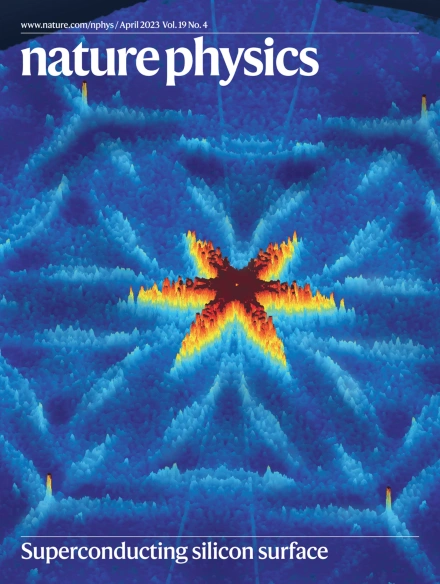Stealing Electrons and Reversing Time
January 30, 2023
UT's physicists led the scientific team that found silicon—a mainstay of the soon-to-be trillion-dollar electronics industry—can host a novel form of superconductivity that could bring rapidly emerging quantum technologies closer to industrial scale production. The findings are reported in Nature Physics and involve electron theft, time reversal, and a little electronic ambidexterity.
Superconductors conduct electric current without resistance or energy dissipation. Their uses range from powerful electromagnets for particle accelerators and medical MRI devices to ultrasensitive magnetic sensors to quantum computers. Superconductivity is a spectacular display of quantum mechanics in action on a macroscopic scale. And it all comes down to the electrons.
Electrons are negatively charged and repel each other in a vacuum. However, in a solid-state medium—the realm of metals and semiconductors—there are roughly 1023 (= 100 billion x one trillion) other electrons and positive ions that complicate the picture enormously. In a superconductor, conduction electrons overcome their mutual repulsion and become attracted to each other through interactions with the other particles. This interaction causes them to pair up like dancers at a ball, forming composite particles, or "Cooper pairs" (so named for Nobel laureate Leon Cooper).
Typically, the "glue" causing this pairing comes from the atom vibrations in a metal, but only if the electrons don't repel each other too strongly. The process is somewhat like two people (the electrons) on a soft mattress (the medium) that roll toward one another when the mattress is compressed in the center. The laws of quantum mechanics dictate that Cooper pairs (unlike single electrons) can all condense into a single coherent quantum state, where they move in lock step. The condensate exhibits a rigidity as a result, allowing current to flow without interruption or dissipation. In other words: to superconduct. This mechanism leads to conventional (s-wave) superconductors such as aluminum, tin, or lead.
When the repulsion between electrons is strong, however, they pair up in higher angular momentum states so that they can't get too close, resulting in, e.g., a d-wave superconductor. This is the case with materials made from copper and oxygen (cuprates) and it plays a starring role in the Nature Physics research and its future potential.

Hanno Weitering

Steve Johnston
In this work, Professor Hanno Weitering and Associate Professor Steve Johnston and their colleagues in the U.S., Spain, and China replicated cuprate-like physics by growing one-third of a monolayer of tin atoms on a substrate (base layer) of silicon. Think of it as nine silicon atoms in a single layer, with three tin atoms—placed farther apart—stacked in another layer on top. The system is engineered such that the repulsion between the tin electrons is so strong they can't move and won't superconduct.
Weitering, Johnston, et al., found a clever workaround by implanting boron atoms in the silicon layer's diamond-like crystal structure. The boron atoms proceeded to steal electrons from the tin layer (typically about 10 percent) in a process similar to techniques perfected by the semiconductor industry. This gave the remaining tin electrons the freedom to move about. The tin layer thus becomes metallic and even superconducting at a critical temperature exceeding that of nearly all elemental superconductors. Importantly, the phenomenon also scales with the number of boron atoms or stolen electrons, behavior reminiscent of the cuprate superconductors.
While electron theft-based superconductivity is interesting in its own right, the research team found even more intriguing physics suggesting this tin-silicon material hosts chiral superconductivity. This highly exotic state of matter is heavily pursued, in part because of its potential for quantum computing.
In chiral systems, clockwise and counterclockwise rotations are the same and yet different—like how left and right hands are mirror images of each other that can't be superimposed. In quantum mechanics, the properties of single or paired electrons are encoded in a mathematical wavefunction that can be left-handed, right-handed, or "topologically trivial." The superconducting wavefunction in the tin layer turns out to be clockwise in parts of the sample and counterclockwise in other parts. If one were to rewind the clock, the clockwise wavefunction would become counterclockwise and vice-versa, but these two wavefunctions are still different, just like the left hand and right hand are different. Or as the physicist would say, time-reversal symmetry is broken.

Featured on the April 23 (Vol. 19, No 4) cover of Nature Physics: A 3D rendition of images from the paper.
This is a quasi-particle interference spectrum of a monatomic superconducting tin layer on a silicon substrate. The bright star at the center originates from quasi-particle scattering processes in which time-reversal symmetry is broken. The latter indicates that the superconductivity is topological in nature.
Time-reversal symmetry breaking is a hallmark of chiral superconductivity. Another is that the system has two one-dimensional conduction channels that run like railroad tracks along the perimeter of the sample material. These channels host exotic particle-like entities (named for Ettore Majorana) where under certain conditions the particle and its antiparticle become indistinguishable. Majorana particles are topologically protected, impervious to what's going on in the environment around them. They've been envisioned as building blocks of future quantum computers, a rapidly emerging technology that could help solve problems too complex for classical computers. The use of Majorana particles implies a safeguard against decoherence, a critical requirement for quantum computation to succeed.
Taken together, the Nature Physics results suggest the possibility of integrating exotic properties with an easily scalable silicon-based materials platform. As such, this would bring futuristic quantum technologies closer to industrial scale production.